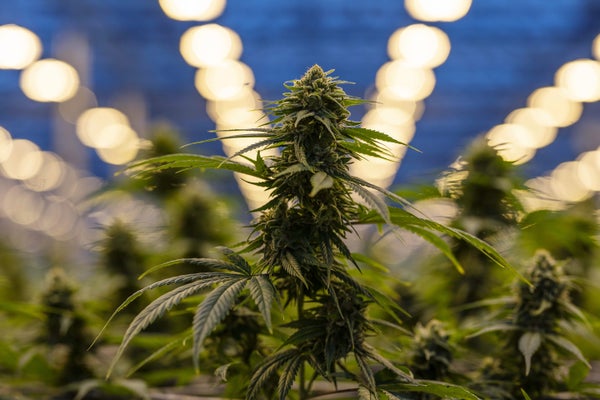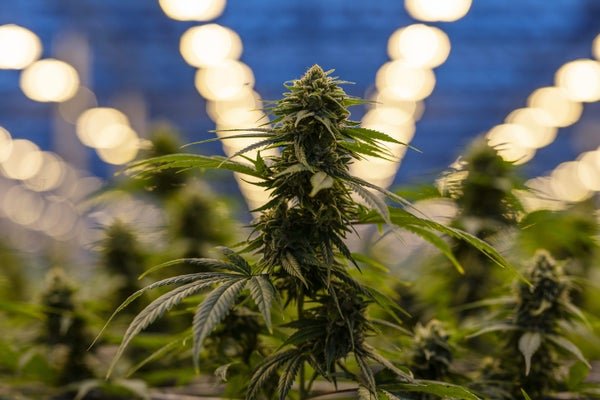We Need to Rethink Our Strategy on Cannabis in the Overdose Crisis
Opioid use disorder treatment needs to take into account evolving cannabis policies, to help give people the best chances of recovery

Chris Roussakis/Bloomberg Creative Photos/Getty Images
The U.S. faces a devastating overdose epidemic, driven initially by pain pills and subsequently by heroin and the synthetic opioid fentanyl. Data from the Centers for Disease Control and Prevention indicate there were more than 81,000 opioid-related overdose deaths last year alone. Millions of American adults experience an opioid use disorder. But as of 2021, four out of five of these individuals did not receive treatment. This discrepancy underscores an urgent need to expand access to medications to help their recovery.
One significant barrier to treatment is a restriction on cannabis use for potential patients. Currently, many opioid use disorder treatment programs require that people abstain from cannabis before qualifying for treatment. This approach highlights a critical failure in addiction medicine: our misguided stance on cannabis has often led to the exclusion of individuals from treatment. We have failed to thoroughly investigate the therapeutic potential of cannabinoids while disqualifying people from opioid treatment programs based on its use. This shortsighted policy potentially blocks thousands of individuals from receiving care—and overlooks the possibility that some constituents of cannabis may have therapeutic benefit. To address the opioid crisis, it is essential to reassess our stance on cannabis to ensure more inclusive and effective treatment approaches, as well as to rigorously assess risks and benefits in a balanced manner.
Over the past decade, as the opioid crisis has intensified, attitudes toward cannabis have also shifted dramatically in the U.S. Cannabis is the fourth most used psychoactive substance in the world, after alcohol, caffeine and tobacco. It contains more than 550 different constituents, the most well-known of which are delta-9-tetrahydrocannabinol (THC) and cannabidiol (CBD). Thirty-eight states and Washington, D.C., have now legalized medical cannabis, with a growing number also allowing it for nonmedical use. Some states have even designated opioid use disorder as a qualifying condition for medical cannabis, although high-quality data supporting this indication are still lacking. Recently, the Biden administration recommended reclassifying cannabis as a drug with less abuse potential at the federal level, a move that would effectively legalize its medical use nationwide. This potential reclassification would mean a shift in federal policy as well. These evolving policies, however, clash with some traditional approaches to opioid use disorder treatment.
On supporting science journalism
If you’re enjoying this article, consider supporting our award-winning journalism by subscribing. By purchasing a subscription you are helping to ensure the future of impactful stories about the discoveries and ideas shaping our world today.
In the U.S., methadone—a lifesaving medication for opioid use disorder—is dispensed through federally regulated opioid treatment programs. These specialized clinics provide daily doses of medication, along with counseling and other support. Many programs, however, enforce strict abstinence policies, disqualifying those who test positive for cannabis or its constituent cannabinoids from receiving treatment. This prohibition is rooted in the assumption that cannabis use impedes recovery. As cannabis legalization expands and attitudes shift, traditional abstinence-based policies are increasingly at odds with growing acceptance of cannabis use. The rise of “California sober,” a lifestyle choice in which individuals abstain from alcohol and other drugs but continue to use cannabis, further highlights this disconnect.
Abstinence policies stem from the belief that cannabis use may undermine opioid use disorder treatment, but emerging evidence, including the results of a January systematic review and meta-analysis we conducted, challenges this assumption. In our review, aggregated data from studies that followed individuals over four to 15 months indicated no significant association between cannabis use and return to nonmedical opioid use among people who were receiving treatment. These findings should make us reconsider the role of cannabis and specific cannabinoids in recovery and reevaluate how policies related to cannabis use impact treatment access and retention.
Some mechanistic findings suggest cannabis and its constituents have potential benefits for opioid use disorder treatment. For instance, some studies indicate that THC might help reduce the need for opioids in pain management and that CBD may help reduce drug-seeking behavior and cravings triggered by environmental cues. Further studies are needed, however, to clarify these findings. There is still a long way to go before any cannabis constituent can be considered an approved treatment for opioid use disorder.
For a medication to gain approval from the U.S. Food and Drug Administration, it must undergo a strict evaluation process based on the gold standard of evidence: randomized, double-blind, placebo-controlled human trials. In these studies, participants are randomly divided into groups, with some receiving the medication being tested and others receiving a placebo. The agency typically requires at least two well-designed trials, usually of more than 200 people, before considering the approval of a new medication. As of now, only relatively small studies have specifically tested the efficacy and safety of cannabinoids for treating opioid use disorder. Until these data are replicated in larger experimental studies, it is important to approach the idea of using cannabinoids to treat opioid use disorder with caution and to rely on proven, FDA-approved treatments for this condition.
Recovery from opioid use disorder is a complex journey. While complete abstinence might be ideal for some, it is often not a reality for many who are early in their recovery process. Harm reduction strategies, which prioritize easing the dangers of drug use, provide a more compassionate and pragmatic approach. Policies that immediately disqualify people from treatment because of their occasional cannabis use fail to account for the nuanced challenges of recovery. Moreover, they may inadvertently push individuals back to dangerous nonpharmaceutical opioids, such as fentanyl and its derivatives.
Our research suggests the need for policy changes. Current evidence questions the justification for zero-tolerance policies that deny opioid use disorder treatment based on cannabis use when preserving access to lifesaving medications is of utmost importance for recovery. To be very clear, we are not promoting cannabis use in opioid use disorder recovery. Rather we see the need for thoughtful, personalized assessments of cannabis’s role relative to treatment goals.
Health care professionals should monitor substance use while also speaking honestly with patients about how cannabis affects their recovery, including its impact on pain, opioid withdrawal and the desire to use other substances nonmedically. We must elucidate the complex relationship between cannabis and recovery from opioid use disorder. Future studies should examine the safety and efficacy of cannabis and its constituents in managing opioid use disorder symptoms and the effects of cannabis-derived products and different consumption patterns on treatment outcomes. This research, combined with thoughtful clinical discussions, can yield more tailored and effective treatment.
As the opioid crisis lingers, we must examine our approaches to ensure that lifesaving care reaches all who need it. We should adopt evidence-based policies that prioritize access to approved medications while cautiously considering the potential role of cannabinoids in helping to treat opioid use disorder. Our utmost priority must be to close the persistent treatment gap. By combining compassion with scientific evidence, we can work toward a more effective, inclusive approach to the opioid crisis, providing better support for those struggling on their path to recovery.
This is an opinion and analysis article, and the views expressed by the author or authors are not necessarily those of Scientific American.



